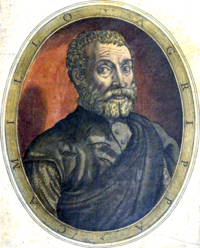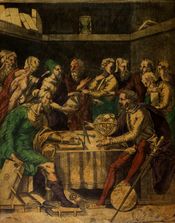|
|
You are not currently logged in. Are you accessing the unsecure (http) portal? Click here to switch to the secure portal. |
Difference between revisions of "Camillo Agrippa"
| Line 107: | Line 107: | ||
| work = Italian Transcription | | work = Italian Transcription | ||
| authors = [[Niccolò Menozzi]] | | authors = [[Niccolò Menozzi]] | ||
| − | | source link = https://books.google.it/books?id= | + | | source link = https://books.google.it/books?id=y5xbAAAAcAAJ&printsec=frontcover&hl=it&source=gbs_ge_summary_r&cad=0#v=onepage&q&f=false/ |
| − | | source title= | + | | source title= Trattato di Scientia d'Arme, con vn Dialogo di Filosofia (Camillo Agrippa) |
| license = noncommercial | | license = noncommercial | ||
}} | }} | ||
Revision as of 21:39, 10 January 2018
| Camillo Agrippa | |
|---|---|
 | |
| Born | 1510s (?) Milan, Italy |
| Died | 1595 Rome, Italy |
| Occupation |
|
| Influenced | |
| Genres | Fencing manual |
| Language | Italian |
| Notable work(s) | |
Camillo Agrippa (1510s–1595) was a 16th century Italian architect, engineer, and fencer. Born in Milan, Agrippa moved to Rome on 26 October 1535 and later became associated with the Confraternity of St. Joseph of the Holy Land. He also moved in literary and artistic circles, where he was acquainted with Cardinal Alessandro Farnese and the great artist Michelangelo.
Though he doesn't seem to have been a professional fencing master, Agrippa stands out as one of the most influential fencing theorists in history. His first treatise, titled Trattato di Scientia d'Arme, con vn Dialogo di Filosofia ("Treatise on the Science of Arms, with a Philosophical Dialogue"), was published in 1553 and presented a unique new system of swordsmanship based on his knowledge of geometry and mechanics.
Agrippa's theories revolutionized civilian fencing and presaged the emergence of the thrusting style that characterized the use of the rapier. The influence of his ideas is seen in virtually every fencing manual published in the subsequent century, including those of Ridolfo Capo Ferro da Cagli, Jerónimo Sánchez de Carranza, Salvator Fabris, and Henry de Sainct Didier.
Contents
Treatises
Images |
Transcription | |
|---|---|---|
| Text to copy over |
Images |
Transcription |
Italian Transcription (1570) | |
|---|---|---|---|
| Text to copy over | CAP. XV.
HAVENDO disignato dire ancora come si adoperasse il Spadone: ma considerato meglio che quanto si potesse dire sarebbe uano, per la incerta regola de le sue botte le quali uanno per l'aria: mi è parso con sotisfattion' di chi lo sà adoperare, & chi non sà , lassar' di ragionarne, non potendo essere, eccetto una confusione d'intelletto ogni auiso, & disciplina che se ne desse, senza il proprio essercitio, ouero effettual demostratione, da alcuno de la professione : auertendo solamente , che ritrouandosi doi con spadoni po tranno fare di punta quelle botte medesime, che si sono descritte di sopra de l'arme d'Asta. |
For further information, including transcription and translation notes, see the discussion page.
| Work | Author(s) | Source | License |
|---|---|---|---|
| Italian Transcription | Niccolò Menozzi | Trattato di Scientia d'Arme, con vn Dialogo di Filosofia (Camillo Agrippa) |
Additional Resources
- Agrippa, Camillo. Fencing: A Renaissance Treatise. Ed. Ken Mondschein. New York: Italica Press, 2009. ISBN 978-1-59910-129-3
References

